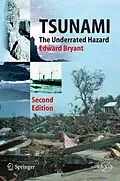Tsunami: The Underrated Hazard, 2nd Edition, comprehensively describes the nature and process of tsunami formation, outlines field evidence for detecting the presence of past events, and describes notable events linked to earthquakes, volcanoes, submarine landslides, and comet impacts. The author provides a clear approach to the study of tsunami, through dynamics, impact on coastlines, and overviews of the various major mechanisms of tsunami generation. Liberal case studies and examples highlight the significance of this underrated natural hazard for coastal societies. In particular, Dr Bryant studies in detail the great tsunami that struck the Indian Ocean on 26 December 2004, making it one of the largest natural disasters to occur in recorded history.
The book is divided into four parts. Part I considers tsunami as a known hazard, starting in Chapter 1 with legends and stories and questioning whether they are scientific fact or legend. Dr Bryant looks at the causes of tsunami, their distribution and fatalities in the Mediterranean and Caribbean Seas, the Pacific Ocean, New Zealand and Australia as well as in bays, fjords, inland seas and lakes. Chapter 2 studies the dynamics of tsunami, their characteristics, the wave theory and the run-up and inundation. In Part II tsunami-formed landscapes are examined, showing both the depositional and erosional signatures of tsunami in the coastal landscape, including chevrons and dune bedforms. The coastal landscape evolution is looked at in Chapter 4, comparing catastrophism against uniformitarianism and tsunami versus storms. Examples and types of coastal landscapes created by tsunami, particularly in Australia, Grand Cayman, the Bahamas and Chilean coast are also given. Part III looks at the main causes of tsunami: earthquakes, great landslides, volcanic eruptions and comets and meteorites. The modern risk of tsunami is covered in Part IV, detailing locations and avoidance, including warning systems. Dr Bryant ends this unique study of a fascinating subject with five stories of different tsunamis.
Autorentext
Dr Edward Bryant is a renowned and respected tsunami researcher, writer and teacher in the areas of natural hazards and climatology. Tsunami: The Underrated Hazard was first published by Cambridge University Press in 2001. This is now out of print and CUP confirmed that all rights in the book have reverted to the author. The 2nd Edition incorporates the great Indian Ocean tsunami in 2004 and the author focuses on geomorphology and the processes and events linked to the main causes of tsunami, namely, earthquakes, volcanoes, landslides and, in addition, comet and meteorite impacts.
Zusammenfassung
In the last three years, there have been three large tsunamis in the Indian Ocean, most notably the notorious one which struck on 26 December 2004 and killed more than 238,000 people. It was generated by one of the largest recorded earthquakes in the last 100 years. Such events occur about four times per century, mainly in the Pacific Ocean. Few scientists were aware that the Indian Ocean was vulnerable: only Thailand had been warned of the potential for such an event. However, tsunami are also insidious local hazards. Since 1990, at least eleven events have impacted on the world's coastlines, causing devastation and loss of life. Tsunami are underrated as major hazards, mainly due to the misconceptions that they occur infrequently compared to other natural disasters and happen along some distant shoreline, most likely in a developing country. Evidence for past great tsunami, or "mega-tsunami" has also recently been discovered along apparently aseismic and protected coastlines, such as those of Australia and Western Europe. These mega-tsunami are caused by either huge submarine landslides or the impact of meteorites and comets with the ocean. With a large proportion of the world's population living on the coastline, the threat from tsunami cannot be ignored.
Inhalt
Tsunami as a known hazard.- Tsunami dynamics.- Tsunami-formed landscapes.- Signatures of tsunami in the coastal landscape.- Coastal landscape evolution.- Causes of tsunami.- Earthquake-generated tsunami.- Great landslides.- Volcanic eruptions.- Comets and asteroids.- Modern risk of tsunami.- Risk and avoidance.- Epilogue.
